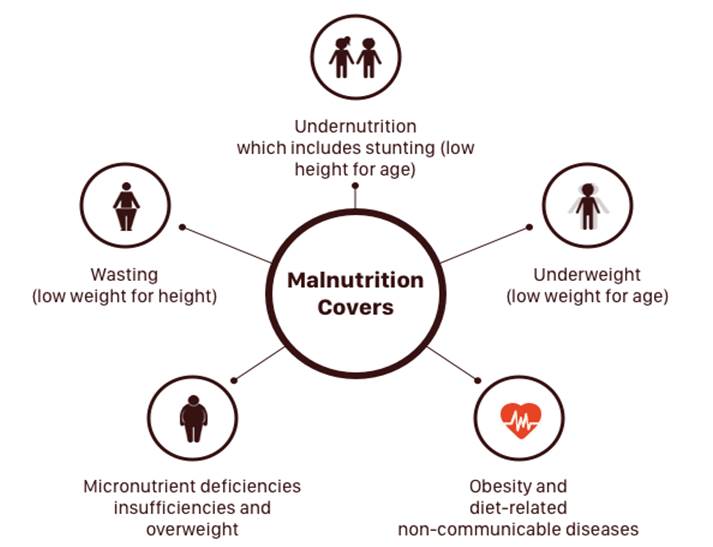Description

Copyright infringement not intended
In News
- The Union Minister of Women and Child Development has released a target report to curb malnutrition in India and updated the Rajya Sabha about the various steps taken by the government to reduce:
- Stunting and under-nutrition (underweight prevalence) by 2% per annum among children under 6 years.
- Low birth weight by 2% per annum.
- Anaemia among children between 6 and 59 months, as well as women and adolescent girls from 15 to 49 years, by 3% per annum.
Background
- According to the National Family Health Survey (NFHS-5), nutrition indicators for children under 5 years of age have improved as compared to NFHS-4 (2015-16).
- Stunting has reduced from 38.4% to 35.5%.
- Wasting reduced from 21.0% to 19.3%.
- Underweight Children down from 35.8% to 32.1%.
- Women (15-49 years) whose BMI is below normal have reduced from 22.9% to 18.7%.
- Despite the decrease, experts have raised concern over the fact that India has one of the highest burdens of malnutrition in the world.
Key Points of the Report
- Meghalaya has the highest number of stunted children (46.5%), followed by Bihar (42.9%).
- Assam, Dadra and Nagar Haveli, Gujarat, Jharkhand, Madhya Pradesh and Uttar Pradesh have stunted children higher than the national average of 35.5%.
- Puducherry and Sikkim have the lowest percentage of stunted children.
- Maharashtra (25.6%) has the highest number of wasted children (weight for height), followed by Gujarat (25.1%).
- Assam, Bihar, Dadra and Nagar Haveli, Karnataka and West Bengal have a higher percentage of wasted children than the national average of 19.3%.
- Bihar (41%) has the highest number of underweight children, followed by Gujarat (39.7%), and Jharkhand (39.4%).
- Assam, Dadra and Nagar Haveli, Karnataka, Madhya Pradesh, Maharashtra and Uttar Pradesh have a higher percentage of underweight children than the national average of 32.1%.
- Jharkhand has the highest percentage of women, between 15 and 49 years, who have a below-normal Body Mass Index (BMI).
- More than 26% of Jharkhand women have below-normal BMI, the national average being 18.5%.
- Bihar, Chhattisgarh, Gujarat, Madhya Pradesh, Maharashtra and Odisha also have high percentages of undernourished women.
Malnutrition
- Malnutrition is the condition that develops when the body is deprived of vitamins, minerals and other nutrients that our body needs to maintain healthy tissues and organ function.
- Malnutrition occurs in people who are either undernourished or overnourished.
- Article 47 of the Indian Constitution mentions the “duty of the State to raise the level of nutrition and the Standard of living and to improve Public health”.
- Reasons
- Poverty, dietary issues and low Social Status.
- Hunger, unemployment, Poverty, Child marriage.
- Weak implementation of government nutrition Schemes.
- Unsafe water, lack of Proper Sanitation and hygiene.
- Ignorance of healthy diet and healthy feeding and Caring practices.
- Lack of Proper Infant & Young Child Feeding practices.
- Lack of Institutional Delivery, Early Childhood Development, Immunization.

Challenges
- In our Country, both obesity and malnutrition are Public health issues.
- Over half of adolescent girls and women are anemic.
- Every 3rd Child is undernourished which leads to several diseases, Child death and maternal mortality.
- Inadequate health infrastructure, inadequate investments in health and other Sectors.
- Anganwadi has good Programmes but due to a lack of Coordination with PHCs, Children tend to miss the necessary nutrient updates.
Steps were taken by the Government
- Promotion of Institutional deliveries through Cash incentive under Janani Suraksha Yojana.
- Janani Shishu Suraksha Karyakaram: Free ante-natal Check-ups, Post-natal Care and treatment of Sick infants till one year of age.
- Newborn Stabilization Units and Kangaroo Mother Care units for Care of Sick babies.
- Home Based Newborn Care is being Provided by ASHAs.
- MAA for improving breastfeeding Practices.
- Mission Indradhnaush: Expanding full immunization Coverage, the introduction of new vaccines.
- POSHAN Abhiyaan to address Malnutrition.
- Iron and folic acid Supplementation for Prevention of Anaemia, home visits by ASHAs to Promote breastfeeding and Promote the use of ORS and Zinc for management of diarrhoea in Children.
- Capacity building of health Care Providers: Training is being conducted under the National Health Mission to build and upgrade the Skills of Health Care Providers.
- Kayakalp initiative to Promote Cleanliness, hygiene and infection control practices in public health facilities.
- The government launched an Action Plan for ‘Undernourishment free India’ by 2022.
- The national nutrition Strategy has Set targets for 2022 and Poshan Abhiyan has Specified 3 years targets to reduce Stunting, undernutrition and low birth weight by 2% each year and to reduce anaemia by 3% each year.
Way Forward
- Need to ensure access to Safe drinking water & Proper Sanitation.
- Dietary diversification, Promote millets and Pulses Production and distribution under Food Security Programme.
- Fortified food into mid-day meals, Public Distribution Shops and Anganwadi Centres.
- Women empowerment can help end malnutrition.
- ICT enabled a real-time monitoring mechanism.
- Improving the infrastructure of Anganwadi Centres along with training of Anganwadi workers.
- Social awareness through both formal and informal channels to generate awareness.
- Campaigns are designed to inform, Communicate and educate on nutrition Specific and nutrition Sensitive behaviors like breastfeeding, diet diversity, hand washing, deworming, Safe drinking water, hygiene and Sanitation.
- Malnourished children must be fed freshly cooked food prepared from locally available cereals, pulses and vegetables.
- Bio-fortification is important in overcoming hidden hunger Caused by micronutrient deficiencies Such as iron, iodine, zinc, vitamin A, and vitamin B12.
- Decrease food loss and waste through more efficient distribution Systems.
- Address the dual burdens of under-nutrition and obesity to ensure full human potential
- Sustainable use of traditional Crops, vegetables, and fruit trees, as well as greater livestock diversity, to increase income and improve food and nutrition Security in India.
https://indianexpress.com/article/india/over-35-5-kids-stunted-govt-releases-target-to-curb-malnutrition-8055777/
1.png)
https://t.me/+hJqMV1O0se03Njk9














